#squawktober
Photo
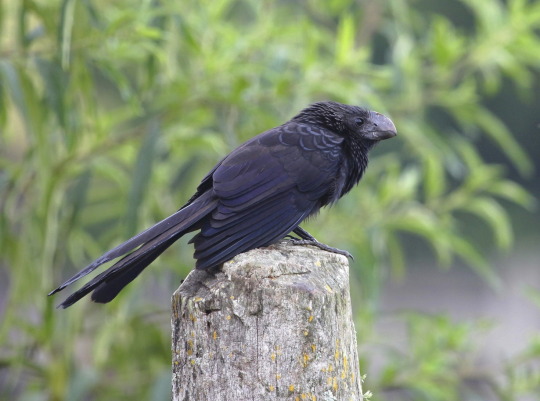



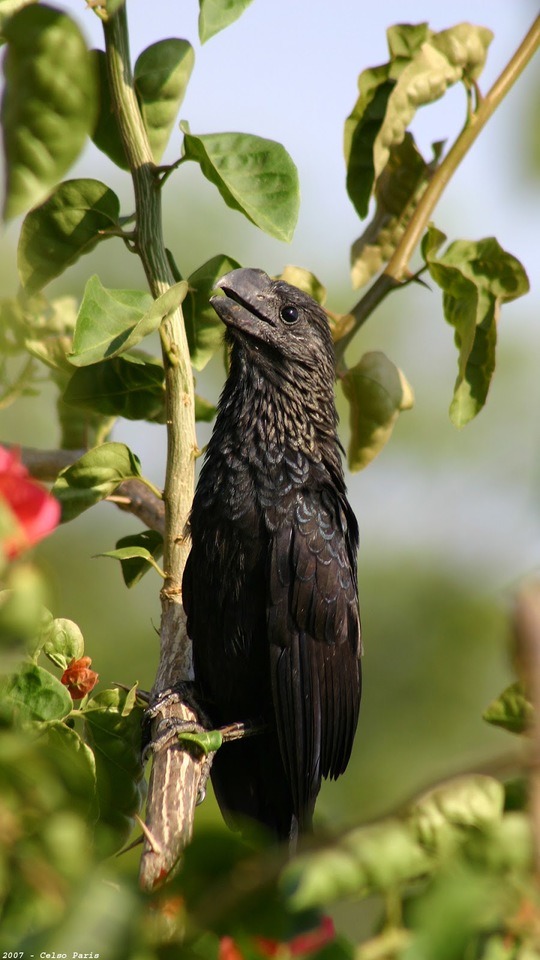
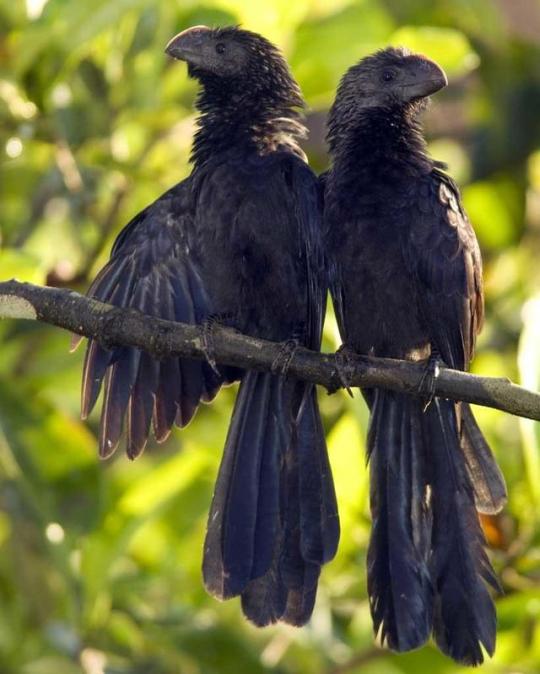




The smooth-billed ani (Crotophaga ani) is a large near passerine bird in the cuckoo family. It is a resident breeding species from southern Florida, the Bahamas, the Caribbean, parts of Central America, south to western Ecuador, Brazil, and northern Argentina. This species is called "el pijul" in Venezuelan folklore.
The smooth-billed ani is a mid-sized species, larger on average than the groove-billed ani but smaller than the greater ani. The adult is mainly flat black, with a long tail, deep ridged black bill and a brown iris. The flight is weak and wobbly, but the bird runs well and usually feeds on the ground. The smooth-billed ani feeds on termites, large insects and even lizards and frogs. They will occasionally remove ticks and other parasites from grazing animals.
This is a very gregarious species, always found in noisy groups. The calls include a whining ooo-leeek. This ani is found in open and semi-open country and areas under cultivation. This common and conspicuous species has greatly benefited from deforestation.
The nest, built communally by several pairs, is a deep cup lined with leaves and placed usually 6.6–19.7 ft high in a tree. A number of females lay their chalky blue eggs in the nest and then share incubation and feeding. Each female is capable of laying up to seven eggs, and nests have been found containing up to 29 eggs, but it is rare for more than ten to hatch. Incubation is 13–15 days, with another 10 days to fledging. Up to three broods may be raised in a season, with the young of earlier broods helping to feed more recent chicks.
44K notes
·
View notes
Photo

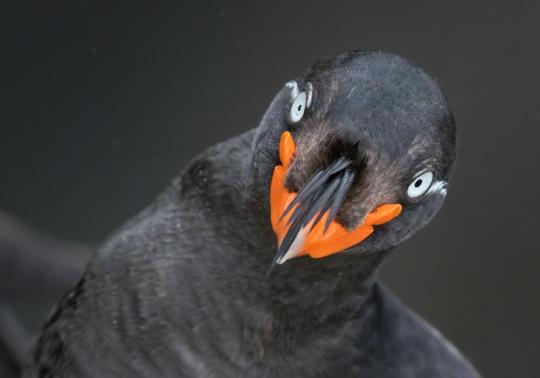



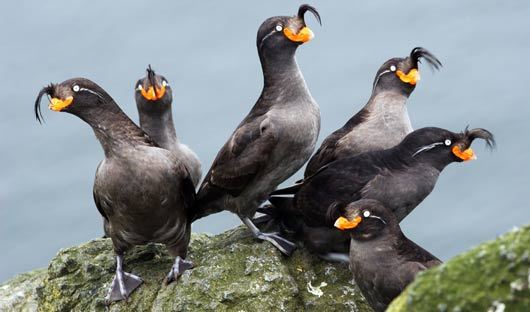



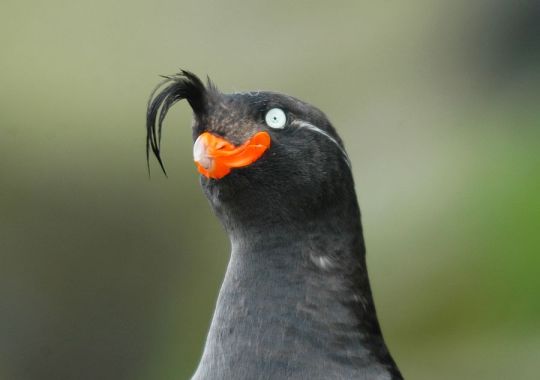
The crested auklet (Aethia cristatella) is a small seabird of the family Alcidae, distributed throughout the northern Pacific and the Bering Sea. The species feeds by diving in deep waters, eating krill and a variety of small marine animals. It nests in dense colonies of up to 1 million individuals in the Bering Sea and the Sea of Okhotsk. The species is known for its sexual ornaments, found in both males and females. These include colorful plumage with a forehead crest, a striking scent recalling citrus fruit, and a loud trumpet call, all of which appear to have evolved through sexual selection.
The crested auklet can measure 7.1–10.6 inches in length, 13–20 inches in wingspan and weigh 195–330 g.They have a reddish-orange and yellow tipped bill, yellowish white irises, and white auricular plumes from their eyes to their ears. Their bodies, wings, and tails are primarily dark sooty grey, while their legs and feet are grey and claws black. The males and females are very similar, although the females have slightly smaller and less curved bills, additionally slightly smaller crests. In winter plumage, their bills are smaller and dull yellow. They lack accessory plates and their crest and auricular plumes are reduced.
Crested auklets are known for their forehead crests, which is made of black forward-curving feathers. These forehead crests are highly variable, and can have between two and twenty three narrow forward curving feathers. The average auklet has 12 crest feathers, which are of variable length, between 8.1 and 58.5 millimetres. Auklets have auricular plumes and a bright orange bill with curved accessory plates. Like forehead crests, these features vary widely within auklet populations.
Crested auklets produce a social odor during the breeding season, described as smelling like tangerines. This odor originates from tiny wick feathers, located in a small patch of skin between the shoulder blades.The scent is released when there is ruffling of feathers on the nape and upper back of the individual from threat, trumpeting, or billing displays. The cloud of scent released encourages the ruff sniff display, when birds fully insert their half open bill into the other's plumage. This display occurs in the absence of obvious aggression and is important for pair formation. For both sexes, a strong odor attracts more individuals.Odor secretions increase during the breeding season, highlighting its association with courtship and mate selection. The scent may also act as an ectoparasite repellent.
Crested auklets are highly social during the breeding season, before pair formation, and after pair formation. Within a breeding year, however, crested auklets are monogamous, with only 10% of the population having extra-pair copulations. Partners continue to self-advertise to other birds when they are not incubating. While some of this advertising behavior can be linked to extra-pair mating, it is suggested that continuation of the behavior allows birds to find pairs for the next breeding season. Only 45.5% of birds remain with the same partner in the subsequent breeding season.
Crested auklets are found throughout the northern Pacific Ocean and Bering Sea. They are particularly prevalent during the non-breeding winter months along the Aleutian Islands, Kuril Islands and the Russian island of Sakhalin. They travel to breeding locations on the islands and shorelines of the Sea of Okhotsk and the Bering Sea during the late spring and summer. Their habitats consist of slopes, boulder fields, lava flows, and sea cliffs.
According to the IUCN, crested auklets are a species of least concern. The global population exceeds 8.2 million individuals, while the North American population is estimated at 2.9 million birds. However, an accurate assessment of the number of birds is difficult, since those on the surface of the colony and in the nearby sea form only a small proportion of the variable and poorly understood population. There is greater concern for the Alaskan population. There has been high predation by rats which have escaped from fishing vessels in the harbor. Oil spills and collisions with light sources (such as fishing boats) pose additional risks.
#crested auklet#aethia cristatella#auks#auklets#black birds#sea birds#squawktober#just look at thes glorious idiots#absolute dorks#i love them
4K notes
·
View notes
Photo
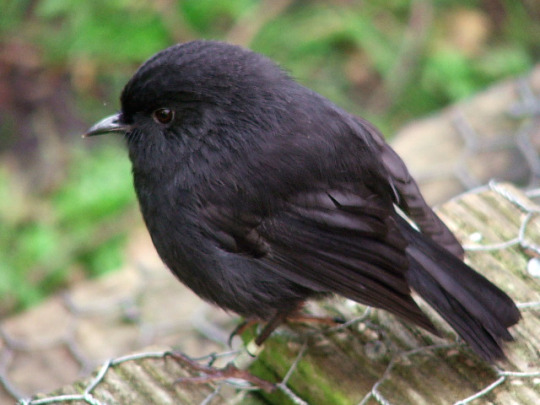



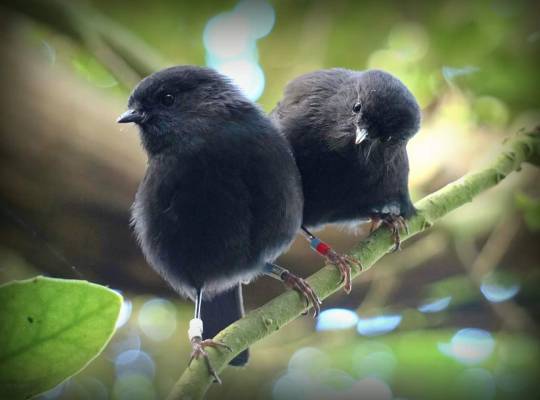
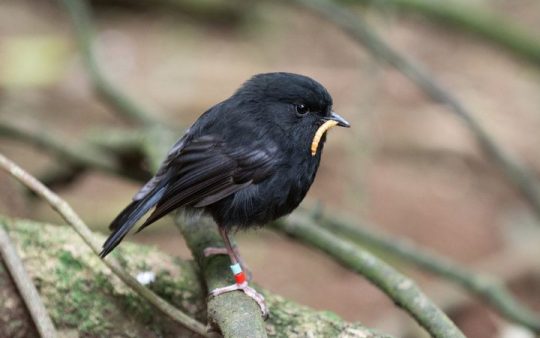
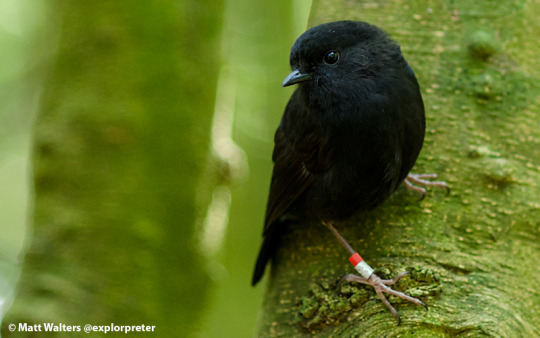



The black robin or Chatham Island robin (Petroica traversi) is an endangered bird from the Chatham Islands off the east coast of New Zealand. Unlike its mainland counterparts, its flight capacity is somewhat reduced. Evolution in the absence of mammalian predators made it vulnerable to introduced species such as cats and rats, and it became extinct on the main island of the Chatham group before 1871, being restricted to Little Mangere Island thereafter.
The black robin is a small, sparrow-sized bird measuring 4–6 inches. Its plumage is almost entirely brownish-black, with a black bill and brownish-black yellow-soled feet. Females are usually slightly smaller than males. Male songs are a simple phrase of 5 to 7 notes. Its call is a high pitched single note. Black robins are territorial. Males will patrol and defend their areas. Females have been known to chase away other females. They make short flights from branch to branch and do not fly long distances.
Black robins live in low-altitude scrub forest remnants. They are entirely insectivorous, and feed on the forest floor or on low branches. Black robins forage in the leaf litter on the ground for grubs, cockroaches, weta, and worms. Black robins will hunt for food during the day and night and have good night vision. Black robins like to nest in hollow trees and tree stumps. They live in woody vegetation, under the canopy of trees - beneath the branches of the akeake trees. To shelter from the strong winds and rough seas around the islands they spend a lot of its time in the lower branches of the forest. They prefer flat areas of the forest with deep litter layers.
There are now around 250 black robins, but in 1980 only five survived on Little Mangere Island. They were saved from extinction by Don Merton and his Wildlife Service team, and by "Old Blue", the last remaining fertile female. The remaining birds were moved to Mangere Island. The team increased the annual output of Old Blue (and later other females) by removing the first clutch every year and placing the eggs in the nest of the Chatham race of the tomtit, a technique known as cross-fostering. The tomtits raised the first brood, and the black robins, having lost their eggs, relaid and raised another brood.
Many females laid eggs on the rims of nests where the eggs could not survive without help. Human conservationists pushed the eggs back into the nests where they were incubated and hatched successfully. The maladaptive gene causing this behaviour spread until over 50% of females laid rim eggs. Humans stopped pushing eggs back in time to prevent the gene spreading to all birds which could have made the birds dependent on humans indefinitely. After human intervention stopped rim laying became less frequent, but 9% of birds still laid rim eggs as of 2011. Conservationists have faced some criticism that they may inadvertently do harm if they allow organisms with deleterious traits to survive and perpetuate what is maladaptive.
All of the surviving black robins are descended from "Old Blue", giving little genetic variation among the population and creating the most extreme population bottleneck possible. However, this does not seem to have caused inbreeding problems, leading to speculation that the species has passed through several such population reductions in its evolutionary past and has lost any alleles that could cause deleterious inbreeding effects. It was generally assumed that the minimum viable population protecting from inbreeding depression was around 50 individuals, but this is now known to be an inexact average, with the actual numbers being below 10 in rapidly reproducing small-island species such as the black robin, to several hundred in long-lived continental species with a wide distribution (such as elephants or tigers).
#black robin#petroica traversi#chatham island robin#endangered species#critically endangered#not quite a lazarus species#black birds#squawktober
4K notes
·
View notes
Photo


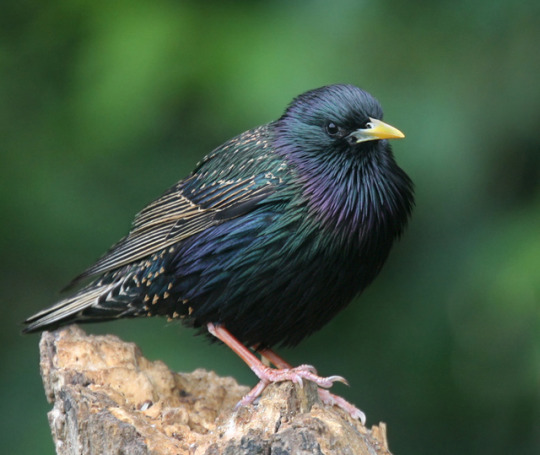


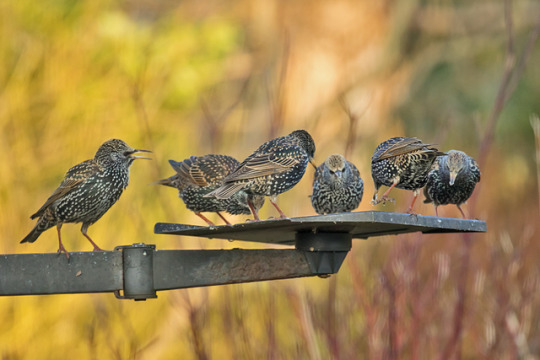




The common starling (Sturnus vulgaris), also known as the European starling, or in the British Isles just the starling, is a medium-sized passerine bird in the starling family, Sturnidae. It is about 8 inches long and has glossy black plumage with a metallic sheen, which is speckled with white at some times of year. The legs are pink and the bill is black in winter and yellow in summer; young birds have browner plumage than the adults. Its gift for mimicry has been noted in literature including the Mabinogion and the works of Pliny the Elder and William Shakespeare.
The common starling has about a dozen subspecies breeding in open habitats across its native range in temperate Europe and western Asia, and it has been introduced to Australia, New Zealand, Canada, United States, Mexico, Peru, Argentina, the Falkland Islands, Brazil, Chile, Uruguay, South Africa and Fiji. This bird is resident in southern and western Europe and southwestern Asia, while northeastern populations migrate south and west in winter within the breeding range and also further south to Iberia and North Africa. The common starling builds an untidy nest in a natural or artificial cavity in which four or five glossy, pale blue eggs are laid. These take two weeks to hatch and the young remain in the nest for another three weeks. There are normally one or two breeding attempts each year. This species is omnivorous, taking a wide range of invertebrates, as well as seeds and fruit. It is hunted by various mammals and birds of prey, and is host to a range of external and internal parasites.
Large flocks typical of this species can be beneficial to agriculture by controlling invertebrate pests; however, starlings can also be pests themselves when they feed on fruit and sprouting crops. Common starlings may also be a nuisance through the noise and mess caused by their large urban roosts.
The plumage is iridescent black, glossed purple or green, and spangled with white, especially in winter. The underparts of adult male common starlings are less spotted than those of adult females at a given time of year. The throat feathers of males are long and loose and are used in display while those of females are smaller and more pointed. Moulting occurs once a year- in late summer after the breeding season has finished; the fresh feathers are prominently tipped white (breast feathers) or buff (wing and back feathers), which gives the bird a speckled appearance. The reduction in the spotting in the breeding season is achieved through the white feather tips largely wearing off. Juveniles are grey-brown and by their first winter resemble adults though often retaining some brown juvenile feathering, especially on the head.
The common starling is a noisy bird. Its song consists of a wide variety of both melodic and mechanical-sounding noises as part of a ritual succession of sounds. The male is the main songster and engages in bouts of song lasting for a minute or more. Each of these typically includes four varieties of song type, which follow each other in a regular order without pause. The bout starts with a series of pure-tone whistles and these are followed by the main part of the song, a number of variable sequences that often incorporate snatches of song mimicked from other species of bird and various naturally occurring or man-made noises. The structure and simplicity of the sound mimicked is of greater importance than the frequency with which it occurs. In some instances, a wild starling has been observed to mimic a sound it has heard only once. Each sound clip is repeated several times before the bird moves on to the next. After this variable section comes a number of types of repeated clicks followed by a final burst of high-frequency song, again formed of several types.
The common starling is a highly gregarious species, especially in autumn and winter. Although flock size is highly variable, huge, noisy flocks - murmurations - may form near roosts. These dense concentrations of birds are thought to be a defence against attacks by birds of prey. Flocks form a tight sphere-like formation in flight, frequently expanding and contracting and changing shape, seemingly without any sort of leader. Each common starling changes its course and speed as a result of the movement of its closest neighbours.
Very large roosts, exceptionally up to 1.5 million birds, can form in city centres, woodlands or reedbeds, causing problems with their droppings. These may accumulate up to 12 inches deep, killing trees by their concentration of chemicals. In smaller amounts, the droppings act as a fertiliser, and therefore woodland managers may try to move roosts from one area of a wood to another to benefit from the soil enhancement and avoid large toxic deposits.
The common starling has been introduced to and has successfully established itself in New Zealand, Australia, South Africa, North America, Fiji and several Caribbean islands. As a result, it has also been able to migrate to Thailand, Southeast Asia and New Guinea.
Since common starlings eat insect pests, they are considered beneficial in northern Eurasia, and this was one of the reasons given for introducing the birds elsewhere. Around 25 million nest boxes were erected for this species in the former Soviet Union, and common starlings were found to be effective in controlling the grass grub Costelytra zelandica in New Zealand. The original Australian introduction was facilitated by the provision of nest boxes to help this mainly insectivorous bird to breed successfully, and even in the US, where this is a pest species, the Department of Agriculture acknowledges that vast numbers of insects are consumed by common starlings.
Common starlings introduced to areas such as Australia or North America, where other members of the genus are absent, may affect native species through competition for nest holes. For its role in the decline of local native species and the damages to agriculture, the common starling has been included in the IUCN List of the world's 100 worst invasive species.
Common starlings can eat and damage fruit in orchards or dig up newly sown grain and sprouting crops.They may also eat animal feed and distribute seeds through their droppings. In eastern Australia, weeds like bridal creeper, blackberry and boneseed are thought to have been spread by common starlings. Agricultural damage in the US is estimated as costing about US$800 million annually. This bird is not considered to be as damaging to agriculture in South Africa as it is in the United States.
2K notes
·
View notes
Photo


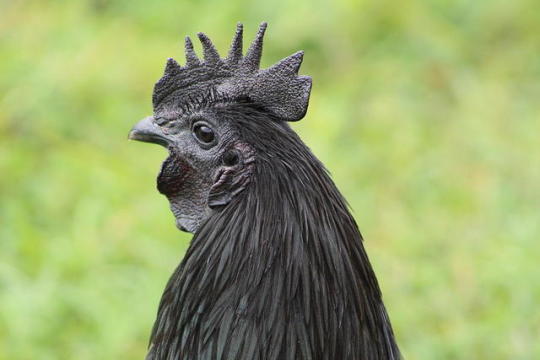
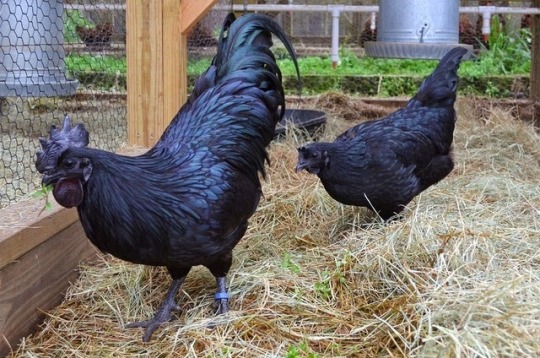

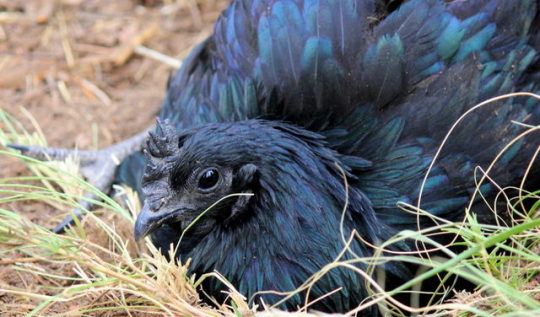

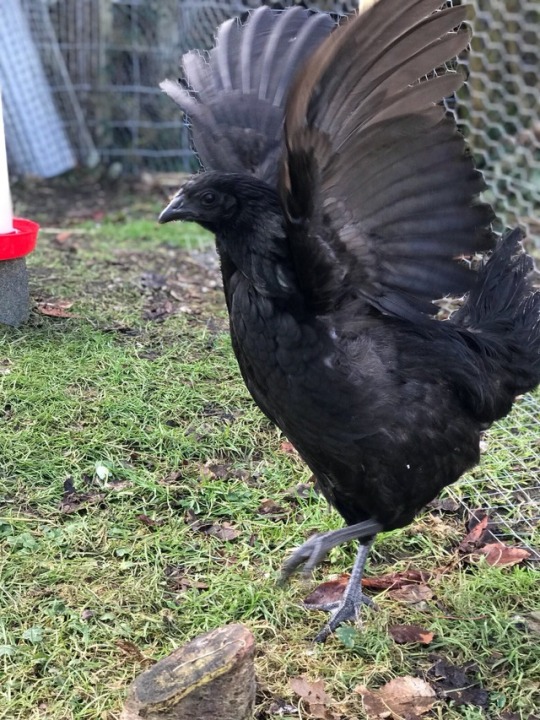
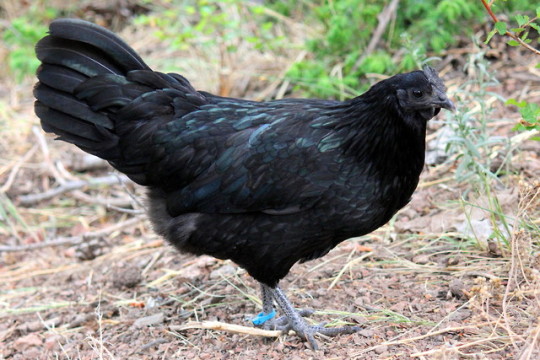
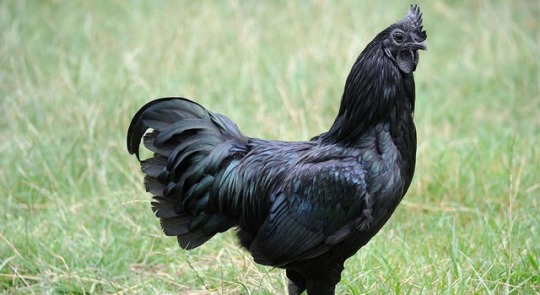
Ayam Cemani is an uncommon and relatively modern breed of chicken from Indonesia. Their beaks and tongues, black combs and wattles, and even their meat, bones, and organs appear black. The birds' black color occurs as a result of excess pigmentation of the tissues, caused by a genetic condition known as fibromelanosis. This gene is also found in some other black fowl breeds. The roosters weigh 2.0–2.5 kg and the hens 1.5–2.0 kg. The hens lay cream-colored eggs
The breed originated from the island of Java, Indonesia. The breed was first described by Dutch colonial settlers and first imported to Europe in 1998 by Dutch breeder Jan Steverink.
1K notes
·
View notes
Photo





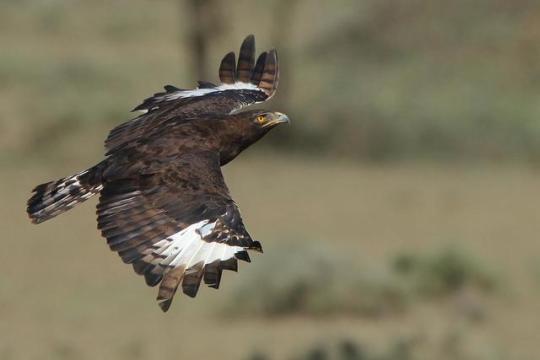
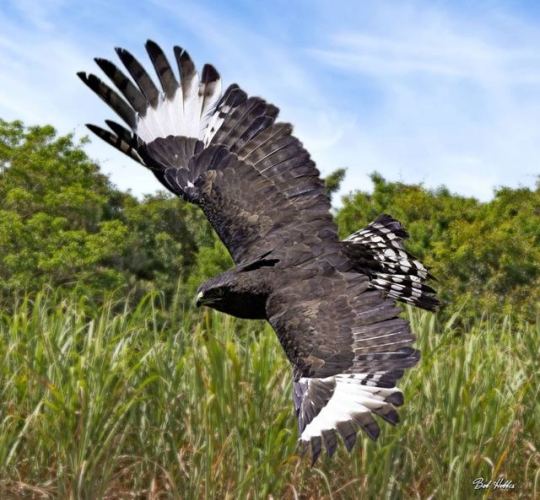



The long-crested eagle (Lophaetus occipitalis) is an African bird of prey. Like all eagles, it is in the family Accipitridae. It is currently placed in a monotypic genus Lophaetus.
The long-crested eagle is a distinctive eagle when perched due to the long, shaggy crest and all dark plumage. The adults are blackish-brown with long, thin feathers growing from the rear of the crown which are held erect to form a crest. The secondary feathers are black barred with light grey and with broad black tips, the primary feathers and median underwing coverts are white, forming a noticeable white patch on the upper and lower surfaces of the wing which is visible in flight. The tail is black, barred with pale grey. The eyes of adults are bright yellow but can be darker in females, and the cere and feet are yellow, paling to white in males. The juveniles are similar to the adults, but the plumage is lighter in color and the crest is not developed and their eyes are grey. The body length is 21–23 inches and the weight of the female is 1,300–1,500 g, while the smaller male is 912–1,300 g.
The long-crested eagle occurs in sub-Saharan Africa from Senegal and Gambia eastwards to Ethiopia and south to the Eastern Cape, in South Africa, northern Namibia and northern Botswana. It is generally regarded as sedentary but in arid areas may be nomadic depending on the rains. The long-crested eagle is a bird of forest edges and moist woodland, particularly if that habitat is near to grassland, marsh, a river or a stream; it can also be found in drier woodland, mixed farmland, grazing land, the edges of sugar-cane plantations and orchards. Long-crested eagles will also use exotic plantations such as those of pine or eucalyptus.
The long-crested eagle is a "sit and wait" hunter which waits on a perch, scanning the ground and swoops on prey with a gliding flight when it come to the bird's notice. Up to 98% of the diet of the long-crested eagle consists of rodents. Birds, including owls and the young of other raptors, frogs and lizards, invertebrates and even fish and fruit were alo recorded as forming part of the diet of this species.
The long-crested eagle is territorial and the male displays during courtship in which he performs steep dives and also uses a rocking, level display flight, they call frequently during these displays. Both sexes build the nest, constructing a stick platform with a bowl-shaped depression in the centre which is lined with green leaves. The nest is normally situated in the mid-canopy and very close to the trunk of a tree near the forest edge. If available, the long-crested eagle will often reuse the nest of another bird. It breeds all year but most eggs are laid in July–November. The female lays 1-2 eggs, and she takes most of the burden of incubating them, incubation lasting 42 days, as she incubates the male provides her with food. As is normal in birds of prey the eggs are laid asynchronously, as much as two weeks apart, and the female begins incubation as soon as the first egg is laid which means that hatching is also asynchronous. When the young hatch they are initially mainly fed by the male. The period from hatching to fledging is about 53 days, and the juveniles remain dependent on the adults for about a further 2–3 months.
974 notes
·
View notes
Photo

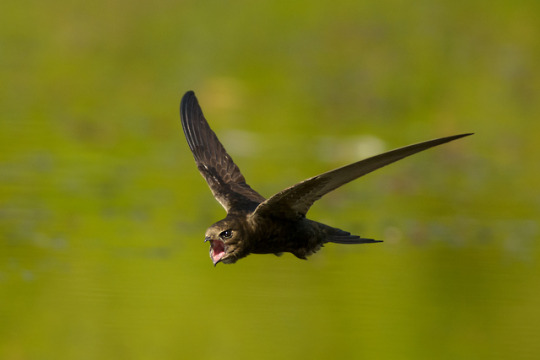

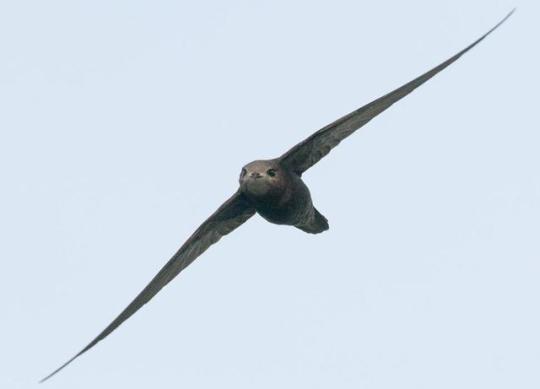





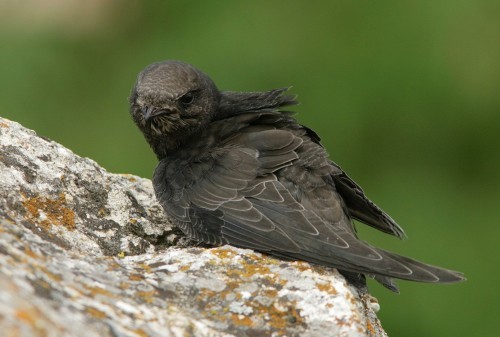
The common swift (Apus apus) is a medium-sized bird, superficially similar to the barn swallow or house martin but somewhat larger. The resemblances between them are due to convergent evolution, reflecting similar contextual development. The swifts' nearest relatives are the New World hummingbirds and the Southeast Asian treeswifts .Its scientific name Apus is Latin for a swift, thought by the ancients to be a type of swallow with no feet (from Ancient Greek α, a, "without", and πούς, pous, "foot"). Swifts have very short legs which they use primarily for clinging to vertical surfaces (hence the German name Mauersegler, literally meaning "wall-glider"). They never settle voluntarily on the ground, where they would be vulnerable to accidents and predation, and non-breeding individuals may spend up to ten months in continuous flight.
Common swifts are 6.3–6.7 inches long with a wingspan of 15–16 inches and are entirely blackish-brown except for a small white or pale grey patch on their chins which is not visible from a distance. They have a short forked tail and very long swept-back wings that resemble a crescent or a boomerang.
Except when nesting, swifts spend their lives in the air, living on the insects caught in flight; they drink, feed, and often mate and sleep on the wing. Some individuals go 10 months without landing. No other bird spends as much of its life in flight. Their maximum horizontal flying speed is 111.6 km/h. Over a lifetime they can cover millions of kilometers.
Swifts build their nests of air-borne material caught in flight, bonded with their saliva, in suitable buildings hollows, such as under tiles, in gaps beneath window sills, and most typically under eaves and within gables. While tree holes and cliffs may have comprised their historic nesting resource, the almost complete removal of ancient forest from their nesting range has resulted in adaptation to man-made sites. Swifts form pairs that may couple for years, and often return to the same nesting site and partner year after year, repairing degradation suffered in their 40-week migratory absence. Insects such as clothes moths, carpet and larder beetles may consume all but the most indigestible nest elements, typically feather shafts.
Common swifts nest in a wider variety of sites than any other species of Apus. Swifts usually nest in buildings but they can also be found nesting in holes in trees, cliffs and crevices, and even in nestboxes. Swifts usually enter their nesting holes with direct flight, and take-off is characterized by an initial free-fall. Empty cavities are shallower than those with nests, and the entry size is smaller in the former than in the latter.
Common swifts are migratory. Their summer breeding range runs from Portugal and Ireland in the West across to China and Siberia in the East. They breed as far south as Northern Africa (in Morocco and Algeria), with a presence in the Middle East in Israel, Lebanon and Syria, the Near East across Turkey, and the whole of Europe as far north as Norway, Finland, and most of sub-Arctic Russia. Swifts migrate to Africa by a variety of routes, ending up in Equatorial and Sub-Equatorial Africa, excluding the Cape. Common swifts do not breed on the Indian Subcontinent.
#common swift#apus apus#swift#mauersegler#wall-glider#birds#10 months in the air!#black birds#squawktober
778 notes
·
View notes
Photo

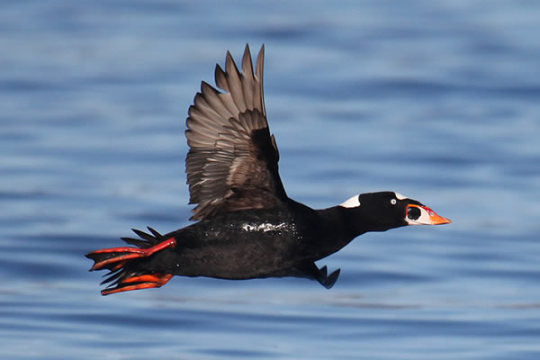








The surf scoter (Melanitta perspicillata) is a large sea duck native to North America. Adult males are entirely black with characteristic white patches on the forehead and the nape and adult females are slightly smaller and browner. Surf scoters breed in Northern Canada and Alaska and winter along the Pacific and Atlantic coasts of North America. These diving ducks mainly feed on benthic invertebrates, mussels representing an important part of their diet.
The adult male is on average 1,050 g (2.31 lb) and 19 inches in length while the adult female averages about 900 g (2.0 lb) and 17 inches in length, making this the smallest species of scoter on average.
The male is completely velvety black except for white patches on the forehead and the nape. It has a swollen bill, appearing orange at a distance but patterned with white, red and yellow, and a black spot near the base. The female is browner than the male, with a fairly uniform plumage, slightly darker above than below. Indistinct paler patches are present on the cheeks below the eye and sometimes a whitish patch is on the nape, a unique trait among scoters. The bill is black with green or blue colorations The juvenile has a plumage similar to the female, but mainly paler and browner, and the breast and belly are whitish.
Like all sea ducks, the surf scoter becomes flightless during the simultaneous molt of its flight feathers. This vulnerable period happens usually in late July through early August and lasts for about four weeks. Before molting the flight feathers, all waterfowl undergo a complete body molt, replacing the bright colors of the basic plumage of males by the duller alternate or eclipse plumage.
This migratory species breeds in the boreal forests near northern freshwater lakes. Very few nests have been observed but they tend to be near spruce cover, slightly upland to wetland areas. To complete its molt before migration, the surf scoter travels to a molting site, which differ from the wintering or the nesting site. Because of the vulnerable state of the ducks in those periods, molting sites are assumed to have profitable food and lower predation risks and they are located in bays, inlets or estuaries. The surf scoter winters in marine habitats near the shore.
Surf scoters form pairs on wintering and staging grounds. Most pairs are formed before the arrival on the breeding grounds. Studies showed a strong fidelity in the nesting areas of surf scoters over the years. Females dig a bowl-shaped nest in the ground and line it with nearby ground debris and down. About 5 to 9 eggs are laid. The incubation lasts for about 28 to 30 days and is provided by the female only. The female usually chooses a feeding area less than 2 meters deep and protected from strong winds for the ducklings. When they reach those food-rich wetlands, they begin feeding on their own. The mother abandons its young before they reach the flight age, at about 55 days.
Adult scoters of this species dive for crustaceans and molluscs, while the ducklings live off any variety of freshwater invertebrates. Important foods include crustaceans, herring spawn, gastropods and small bivalves such as mussels. Surf scoter usually captures its food underwater and consumes it whole. They have been observed to select smaller bivalves than those available, probably because of the energy cost of processing shell matter. They also seem to select slow-swimming epifaunal crustaceans.
The extremely large range and population size of the surf scoter assures it a status of Least Concerned, according to the IUCN. The global population is estimated to be between 250,000 and 1,300,000 individuals. The populations have been apparently decreasing over the last years, but this small decline is not rapid enough to consider moving the species in the Vulnerable category.
541 notes
·
View notes
Photo

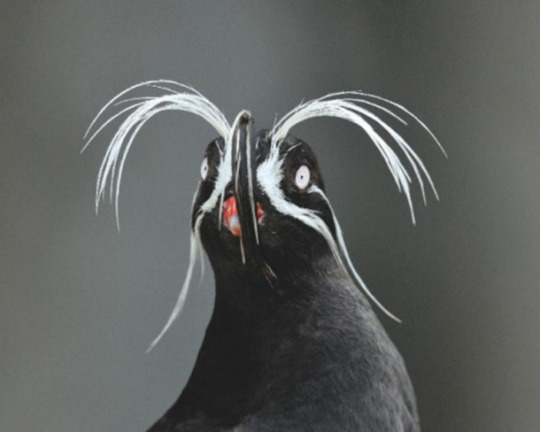
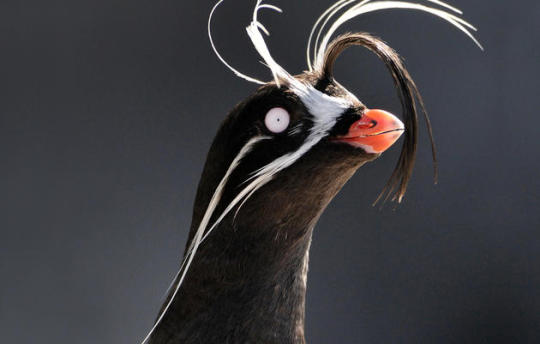
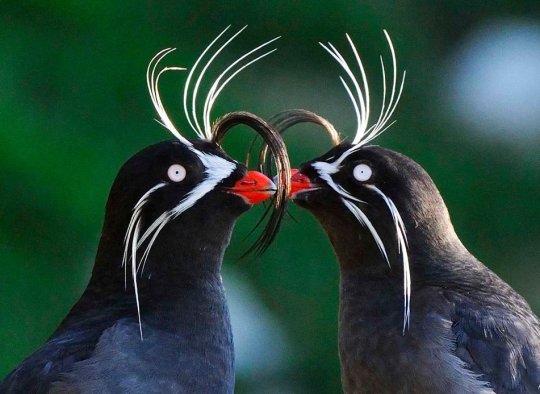


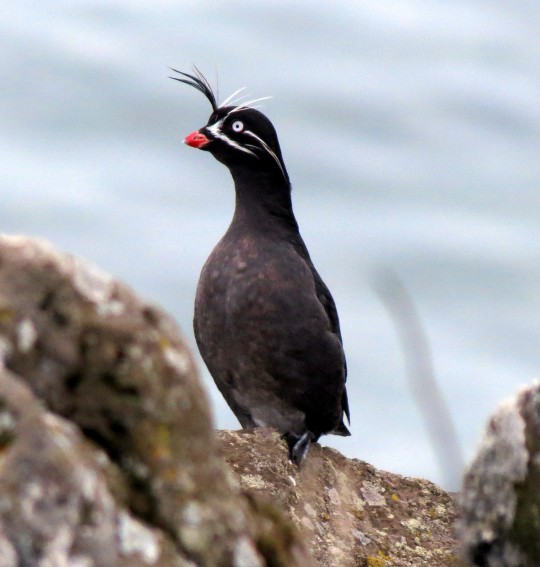



The whiskered auklet (Aethia pygmaea) is a small seabird of the auk family. It has a more restricted range than other members of its genus, Aethia, living only around the Aleutian Islands and on some islands off Siberia (like Commander Islands), and breeding on these islands. It is one of the smallest alcids, only the closely related least auklet being smaller. Its name is derived from the long white feathers on its face that are part of its breeding plumage. An odd characteristic of this bird is that its plumage smells of citrus.
It is not thought to undertake migration, but instead attends its breeding islands year round, and has been shown to roost on land all year round, an unusual trait in the family. Whiskered auklets lay a single egg in a rocky crevice, in loose colonies with other whiskered auklets and also other colonial seabirds. Both parents take part in incubation and chick rearing. The whiskers have been shown to help them sense their way to and out of their nests at night.
Whiskered auklets feed in the inshore zone, usually within 16 km of land, where tidal currents concentrate their prey into dense swarms. They feed predominantly on copepods during the summer months, mostly on the species Neocalanus plumchrus; and switching to euphausiid krill in the fall and winter.
Fishing boats pose a huge threat to this bird, since it is attracted to lights at night. Little is known about population levels or trends in this species, but the introduction of foxes and rats on many of its nesting islands is thought to have reduced numbers. Despite these threats the whiskered auklet is listed as a species of Least Concern on the ICUN Red List because of it’s large range and population size. The population trend appears to be decreasing, howerver the decline is not believed to be sufficiently rapid to approach the thresholds for Vulnerable under the population trend criterion (>30% decline over ten years or three generations).
[x] [x]
363 notes
·
View notes
Photo


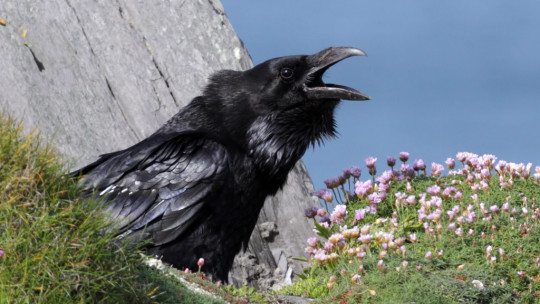

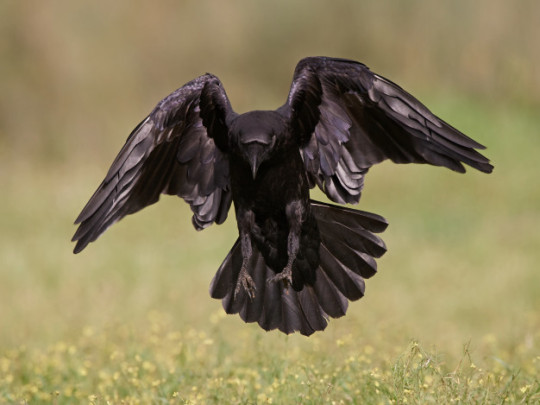
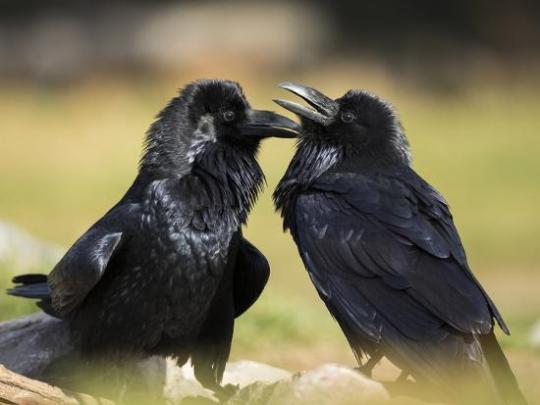

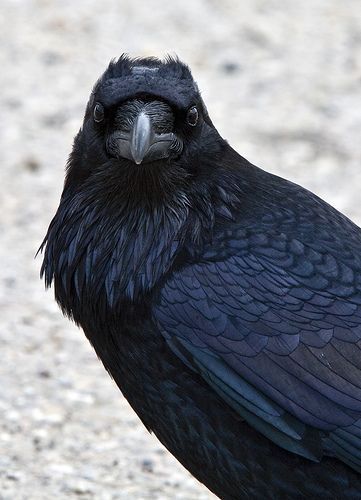


The common raven (Corvus corax), also known as the northern raven, is a large all-black passerine bird. Found across the Northern Hemisphere, it is the most widely distributed of all corvids. It is one of the two largest corvids, alongside the thick-billed raven, and is possibly the heaviest passerine bird; at maturity, the common raven averages 25 inches in length and 2.6 pounds in mass. Common ravens can live up to 21 years in the wild, a lifespan surpassed among passerines by only a few species.
Common ravens have coexisted with humans for thousands of years and in some areas have been so numerous that people have regarded them as pests. Some notable feats of problem-solving provide evidence that the common raven is unusually intelligent. Over the centuries, it has been the subject of mythology, folklore, art, and literature. In many cultures the common raven has been revered as a spiritual figure or godlike creature.
Common ravens usually travel in mated pairs, although young birds may form flocks. Relationships between common ravens are often quarrelsome, yet they demonstrate considerable devotion to their families. Juvenile common ravens are among the most playful of bird species. They have been observed to slide down snowbanks, apparently purely for fun. They even engage in games with other species, such as playing catch-me-if-you-can with wolves, otters and dogs. Common ravens are known for spectacular aerobatic displays, such as flying in loops or interlocking talons with each other in flight. They are also one of only a few wild animals who make their own toys. They have been observed breaking off twigs to play with socially.
Across its range in the Northern Hemisphere, and throughout human history, the common raven has been a powerful symbol and a popular subject of mythology and folklore.
In some Western traditions, ravens have long been considered to be birds of ill omen, death and evil in general, in part because of the negative symbolism of their all-black plumage and the eating of carrion. In Sweden, ravens are known as the ghosts of murdered people, and in Germany as the souls of the damned. In Danish folklore, valravne that ate a king's heart gained human knowledge, could perform great malicious acts, could lead people astray, had superhuman powers, and were "terrible animals". In Persia and Arabia the raven was held as a bird of bad omen but a 14th-century Arabic work reports use of the raven in falconry.
In Tlingit and Haida cultures, raven was both a trickster and creator god. Related beliefs are widespread among the peoples of Siberia and northeast Asia. The Kamchatka Peninsula, for example, was supposed to have been created by the raven god Kutkh.
In Norse mythology, Huginn (from the Old Norse for "thought") and Muninn (Old Norse for "memory" or "mind") are a pair of ravens that fly all over the world, Midgard, and bring the god Odin information. Additionally among the Norse, raven banner standards were carried by such figures as the Jarls of Orkney, King Cnut the Great of England, Norway and Denmark, and Harald Hardrada.
In the British Isles, ravens also were symbolic to the Celts. In Irish mythology, the goddess Morrígan alighted on the hero Cú Chulainn's shoulder in the form of a raven after his death. In Welsh mythology they were associated with the Welsh god Bran the Blessed, whose name translates to "raven." According to the Mabinogion, Bran's head was buried in the White Hill of London as a talisman against invasion. A legend developed that England would not fall to a foreign invader as long as there were ravens at the Tower of London; although this is often thought to be an ancient belief, the official Tower of London historian, Geoff Parnell, believes that this is actually a romantic Victorian invention.
In the Jewish, Christian and Islamic traditions, the raven was the first animal to be released from Noah's Ark. "So it came to pass, at the end of forty days, that Noah opened the window of the ark which he had made. Then he sent out a raven, which kept going to and fro until the waters had dried up from the earth. He also sent out from himself a dove, to see if the waters had receded from the face of the ground." The raven is mentioned a dozen times in the Bible. In the New Testament Jesus tells a parable using the raven to show how people should rely on God for their needs and not riches (Luke 12:24). The raven is also mentioned in Quran at the story of Cain and Abel. Adam's firstborn son Cain kills his brother Abel but he doesn't know what to do with the corpse: "Then Allah sent a raven scratching up the ground, to show him how to hide his brother's naked corpse. He said: Woe unto me! Am I not able to be as this raven and so hide my brother's naked corpse? And he became repentant."
326 notes
·
View notes
Photo


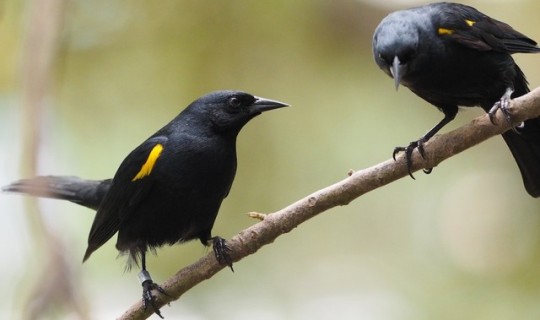


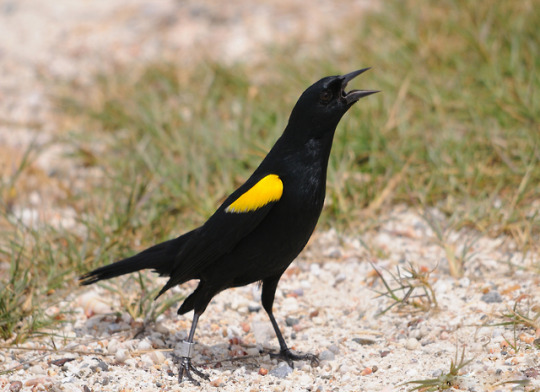
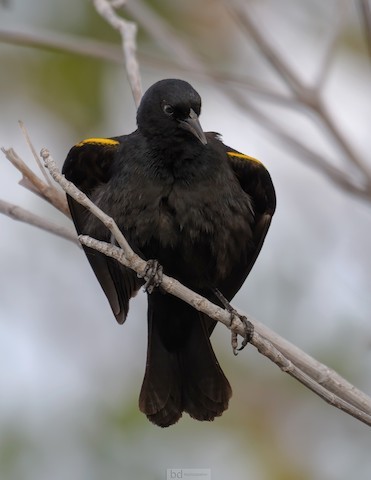

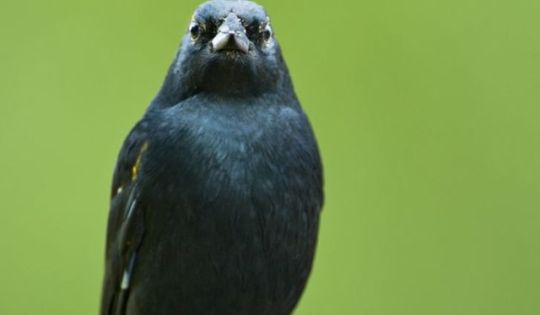

The yellow-shouldered blackbird (Agelaius xanthomus), also known as la Mariquita de Puerto Rico or capitán, is a diurnal blackbird endemic to the archipelago of Puerto Rico and belongs to the genus Agelaius of the family Icteridae. The species is closely related to, and possibly derived from, the red-winged blackbird (Agelaius pheoniceus). It has black plumage with a prominent yellow shoulder on its wing. Adult males and females are of similar appearance. The species is predominantly insectivorous.
The yellow-shouldered blackbird, as its name implies, is a glossy black bird with a small yellow humeral patch around its "shoulders" outlined by a white margin. Immature individuals possess a duller coloration and a brown abdomen. Although plumage coloration is indistinguishable between the sexes, sexual dimorphism is present in this species with males being larger than females. Adult individuals measure from 7.9–9.1 inches; on average, males weigh 41 g and females weigh 35 g.
The species was once commonly found in the coastal forests of the archipelago of Puerto Rico but during the early 20th century these forests were destroyed to allow for the development of sugarcane plantations. After the decline of the sugar industry after the 1930s the coastal areas were developed for housing. As a result, the species is now limited to three areas: the islands of Mona and Monito; the Roosevelt Roads Naval Station area in eastern Puerto Rico; and the southern Puerto Rican dry forests and mangroves.
The destruction of habitat and brood parasitism by the shiny cowbird (Molothrus bonariensis) led to a drastic population decline from the mid-1970s to early 1980s. In 1976, the population of the nominate form was estimated at 2000 individuals but in 1982 the population estimate dropped to 300 individuals. Conservation efforts have increased the population to 1250 pairs.
Yellow-shouldered blackbirds are omnivorous, but are considered to be arboreal insectivores since the majority of their diet consists of insects. During the nesting season their diet is composed of 90% arthropod material. Aside from natural material, the species also consumes processed food such as cattle ration, human food (cooked rice and sugar), dog food and monkey chow.
The species is believed to be monogamous with a single attempt at nesting per year and with nesting being performed in loose colonies. Nests of both the nominate form and the Mona subspecies contain from one to four eggs with an average of three. Eggs are blue-green with brown spots and are incubated for 13 days by the female. As with other Agelaius species, it usually builds open, cup-shaped nests in trees, but nest locations and shapes may vary depending on location and availability of building materials. The Roosevelt Roads' population builds nests on hollows in dead mangroves, while the Mona subspecies builds nests in ledges or crevices near the coastal cliffs.
Building of the nest is performed solely by females while feeding of the young is performed by both sexes. Nestlings leave the nest 13 to 16 days after hatching. Males defend small territories, usually around 3 metres, during the nesting period. Before the nesting period males defend slightly larger territories to repel other males. The species engages in mobbing, a behavior in which a pack of birds, from one or more species, attack a known predator (usually to defend eggs or hatchlings).
Yellow-shouldered blackbirds engage in anting, a rare behavior only observed in the Puerto Rican tanager among West Indian birds. Individuals were observed applying Pheidole species ants to their body and feathers for a short period of time (8 minutes).
The yellow-shouldered blackbird was listed as an endangered species on November 19, 1976 by the U.S. Fish and Wildlife Service. Nest predation has been an important contributor to the decline of the yellow-shouldered blackbird. Known terrestrial predators include rats, mongooses and feral cats, all introduced species to Puerto Rico. Rats constituted the main nest predator eating both eggs and hacthlings. A 1983 report concluded that rat predation accounted for 48% of nest failures that year. Since the middle 1980s artificial PVC nesting structures have been created in mudflats surrounding mangrove forests to reduce rat predation. These structures replaced old wooden nesting boxes and were readily accepted by the species. Presently, few (one or two) natural nests are observed each year in the area. The loss of feeding and breeding habitat and brood parasitism by the shiny cowbird are among other threats that limit and endanger the yellow-shouldered blackbird populations. Natural predators also represent a threat, although minor, to the populations.
#yellow-shouldered blackbird#agelaius xanthomus#a Mariquita de Puerto Rico#capitán#endangered species#blackbird#black birds#squawktober
405 notes
·
View notes
Photo





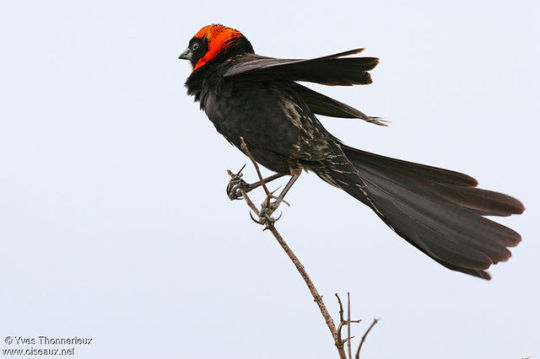
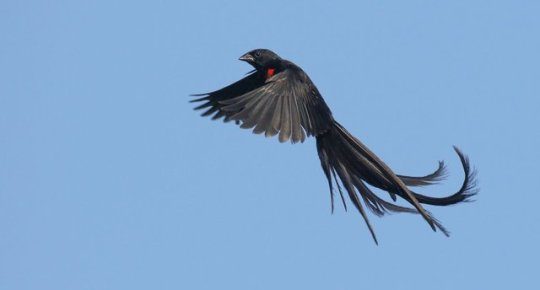
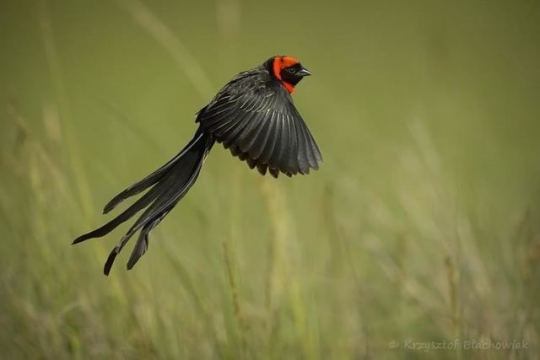

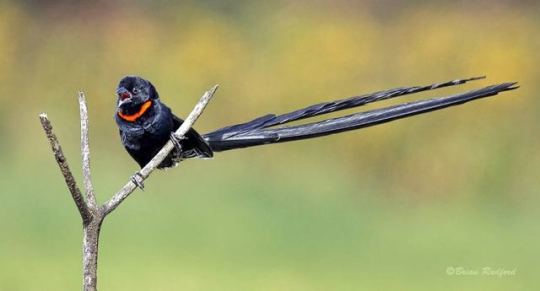
The red-collared widowbird (Euplectes ardens) is a species of bird in the family Ploceidae. Red-collared widowbirds are found in grasslands and bush clearings in Eastern and Southern Africa. They are known for their long tails and brilliant red badges, both of which act as sexual ornaments. They are often associated with other widowbird and bishop species. They are polygynous, where males acquisition of territory is an important determinant in their access to mates. The red-collared widowbirds are not considered to be globally threatened. They have a very wide range and are found commonly in many regions.
Similar to other widowbirds, male red-collared widowbirds have both seasonal and sexual dimorphism. Males are about 9.8 inches in length while females are only about 11 inches. A similar trend is seen with weight, where males range from 20 to 26 g and females are only between 16 and 22 grams. During non-breeding seasons, the male plumage is brown, while in breeding season, October to April, they have black plumage with a long tail, approximately 8.6 inches, and crescent-shaped carotenoid based chest patch. The red-collared widowbird has one of the highest measured plumage carotenoid concentrations in birds. There is a high presence of lutein and zeaxanthin in the feathers, which is consistent with their high dietary consumption of grass seeds. There is significant variation in brightness, hue, and chroma of the carotenoid badges. In contrast, females and subadults, like nonbreeding males, are streaky dull brown with a short tail, approximately 1.5 inches. Nonbreeding males, however, retain their black tails, while females and subadults' tails are dark-brown.
In the red-collared widowbird there is a strong trade-off between carotenoid coloration, which is an agonistic signal and tail length, which is an epigamic signal, directly attracting females. During prenuptial moulting, prior to the breeding season, the males replace their non-breeding feathers. Males that hold territory have shorter tails and carotenoid collars that are 40% larger than nonbreeding floating males . The red collar is for male-male competition, while female choice is based on tail length. Tail length is negatively correlated with carotenoid signal. Also, looking at body size and condition, this accounts for 55% of the variation in tail length. Female preference for long tails was first observed in long-tailed widowbirds, and then subsequently observed in Jackson's widowbird and the red-collared widowbird. Tail length explains 47% of the male's reproductive success, indicating the strength of this sexual ornament.
The red collar functions as a dominance signal, which was supported experimentally through manipulation of the badges. The experiment showed that red-collared males dominated orange males, which in turn dominated brown and blue collared males. Furthermore, with additional manipulation of badges, males with enlarged red, enlarged orange, and reduced red collars obtained territories, while those with reduced orange and blackened or removed collars failed to establish or maintain territories. Lastly, males with reduced signals defended smaller territories, had more intruders, and spent more time, thus increased cost, on aggressive interactions. Collectively, these observations led to the conclusion that redness, and to a lesser degree size, indicate dominance status and fighting ability in male contests.
The tail length itself is the strongest predictor of mating success. However, when the tails were experimentally manipulated, comparing a shortened tail to the control, these males had equal success in acquiring territory with no difference in size or quality. The long-tailed controls spent less time flying and performing courtship displays and they attracted higher quality and more nesting females compared to short-tailed males. Demonstrating the high cost of the long tail, the control birds with longer tails showed a more significant decline in condition, measured by relative body mass, compared with shorter tailed birds. Additionally, longer tails are aerodynamically costly, hindering flying ability by increasing drag. Both the short tailed and control residents have declined condition compared to the floaters, the males who did not establish territories, which suggests an interaction between tail lengths and there is high cost of territory acquisition, defense, and courtship displays.
Red-collared widowbirds feed on seeds of sorghum and other grass seeds. They also feed on nectar, small berries, and insects, specifically ants, caterpillars, and termites. They often form large roosts, with between 50 and 100 individuals, which feed together on the ground.
348 notes
·
View notes
Photo
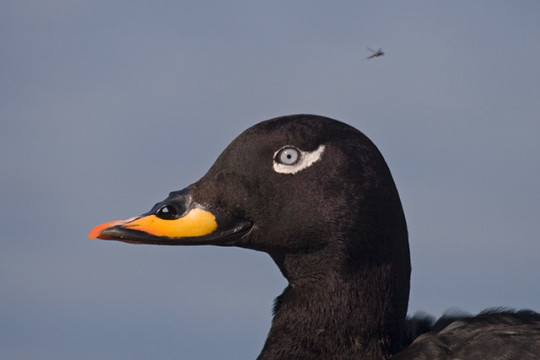




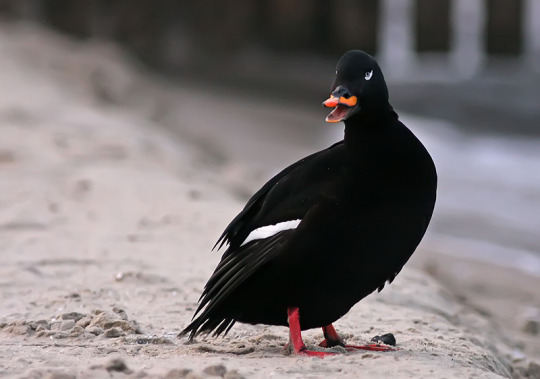

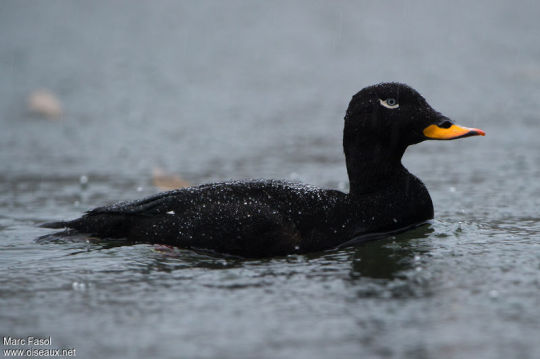
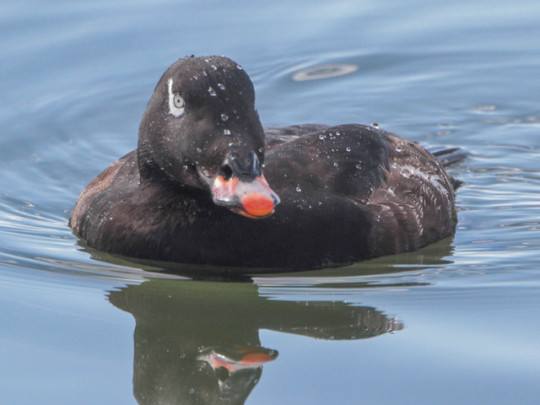
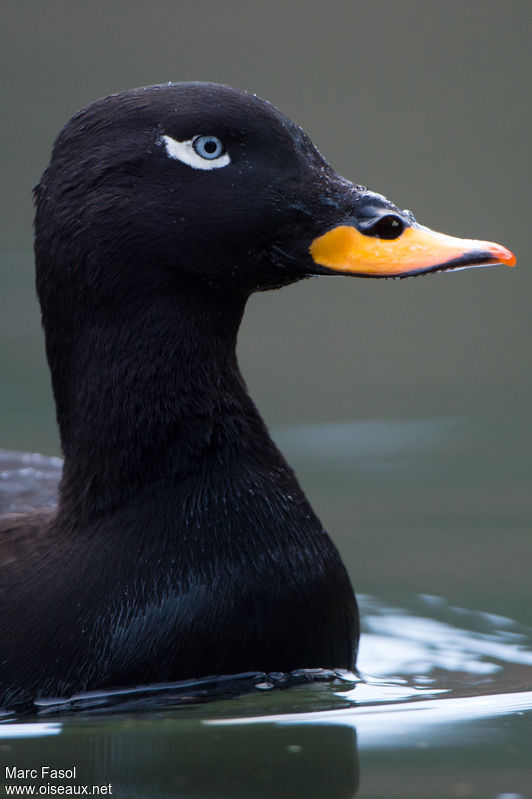
The velvet scoter (Melanitta fusca), also called a velvet duck, is a large sea duck, which breeds over the far north of Europe and Asia west of the Yenisey basin. The genus name is derived from Ancient Greek melas "black" and netta "duck". The species name is from the Latin fuscus "dusky brown".
Stejneger's scoter and the white-winged scoter are sometimes considered conspecific with the velvet scoter. Velvet, Stejneger's, and white-winged scoter, along with the surf scoter, are placed in the subgenus Melanitta, distinct from the subgenus Oidemia, black scoter and common scoters.
The velvet scoter is characterised by its bulky shape and large bill. It is the largest scoter at 20–23 inches. The male is all black, except for white around the eye and a white speculum. It has a bulbous yellow bill with a black base. The females are brown birds with two pale patches on each side of the head and white wing patches.
The lined nest is built on the ground close to the sea, lakes or rivers, in woodland or tundra, and typically contains 7–9 eggs. This duck dives for crustaceans and molluscs.
The velvet scoter winters farther south in temperate zones, Europe as far south as Great Britain, and on the Black and Caspian Sea. Small numbers reach France and northern Spain. It forms large flocks on suitable coastal waters. These are tightly packed, and the birds tend to take off together. The species is listed as Vulnerable by the IUCN.
318 notes
·
View notes
Photo
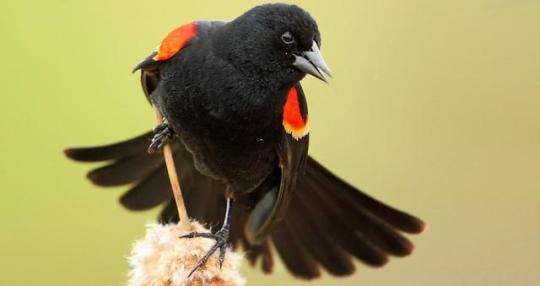

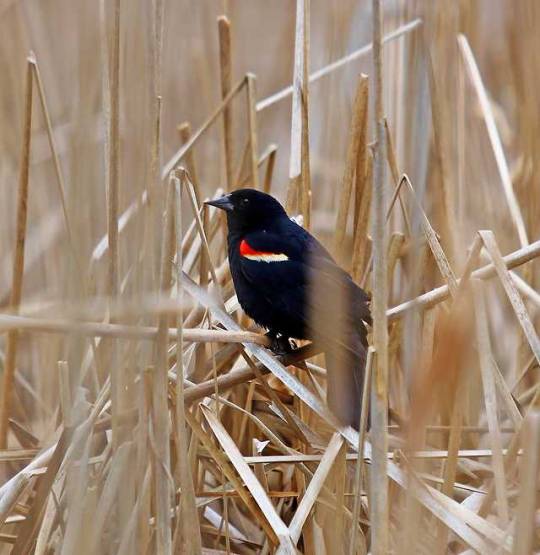

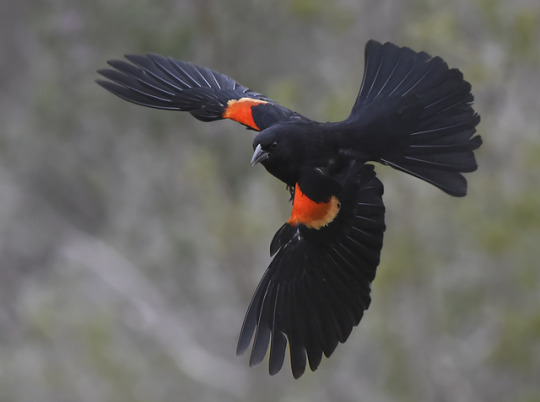


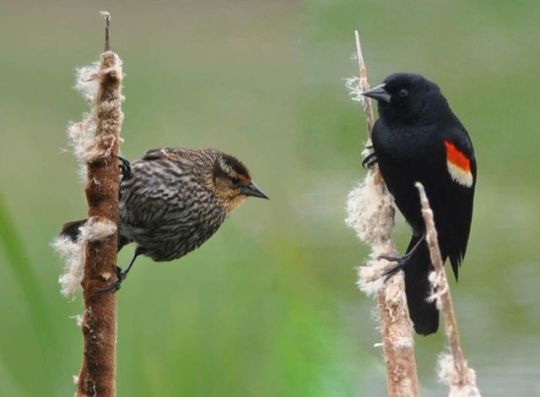


The red-winged blackbird (Agelaius phoeniceus) is a passerine bird of the family Icteridae found in most of North America and much of Central America. Claims have been made that it is the most abundant living land bird in North America, as bird-counting censuses of wintering red-winged blackbirds sometimes show that loose flocks can number in excess of a million birds per flock and the full number of breeding pairs across North and Central America may exceed 250 million in peak years. It also ranks among the best-studied wild bird species in the world. The red-winged blackbird is sexually dimorphic; the male is all black with a red shoulder and yellow wing bar, while the female is a nondescript dark brown. Despite the similar names, the red-winged blackbird is in a different family from the European redwing and the Old World common blackbird, which are thrushes (Turdidae).
The common name for the red-winged blackbird is taken from the mainly black adult male's distinctive red shoulder patches, or epaulets, which are visible when the bird is flying or displaying. At rest, the male also shows a pale yellow wingbar. The female is blackish-brown and paler below. The males of the bicolored subspecies lack the yellow wing patch of the nominate race, and the females are much darker than the female nominate.Young birds resemble the female, but are paler below and have buff feather fringes. Both sexes have a sharply pointed bill. The tail is of medium length and is rounded. The eyes, bill, and feet are all black. The female is smaller than the male, at 6.7–7.1 inches long and weighing 41.5 g, against his length of 8.7–9.4 inches and weight of 64 g.
The range of the red-winged blackbird stretches from southern Alaska to the Yucatan peninsula in the south, and from the western coast of North America to the east coast of the continent. Red-winged blackbirds in the northern reaches of the range are migratory, spending winters in the southern United States and Central America. Migration begins in September or October, but occasionally as early as August. In western and Central America, populations are generally non-migratory.
The red-winged blackbird inhabits open grassy areas. It generally prefers wetlands, and inhabits both freshwater and saltwater marshes, particularly if cattail is present. It is also found in dry upland areas, where it inhabits meadows, prairies, and old fields. The red-winged blackbird is omnivorous. It feeds primarily on plant materials, including seeds from weeds and waste grain such as corn and rice, but about a quarter of its diet consists of insects and other small animals, and considerably more so during breeding season.
The red-winged blackbird nests in loose colonies. The nest is built in cattails, rushes, grasses, sedge, or in alder or willow bushes. The nest is constructed entirely by the female over the course of three to six days. It is a basket of grasses, sedge, and mosses, lined with mud, and bound to surrounding grasses or branches. It is located 3.0 in to 14 ft above water.
Red-winged blackbirds are polygynous, with territorial males defending up to 10 females. However, females frequently copulate with males other than their social mate and often lay clutches of mixed paternity. Pairs raise two or three clutches per season, in a new nest for each clutch. A clutch consists of three or four, rarely five, eggs. Eggs are pale bluish green, marked with brown, purple, and/or black, with most markings around the larger end of the egg. These are incubated by the female alone, and hatch in 11 to 12 days. Red-winged blackbirds are hatched blind and naked, but are ready to leave the nest 11 to 14 days after hatching.
Since nest predation is common, several adaptations have evolved in this species. Group nesting is one such trait which reduces the risk of individual predation by increasing the number of alert parents. Nesting over water reduces the likelihood of predation, as do alarm calls. Nests, in particular, offer a strategic advantage over predators in that they are often well concealed in thick, waterside reeds and positioned at a height of one to two meters. Males often act as sentinels, employing a variety of calls to denote the kind and severity of danger. Mobbing, especially by males, is also used to scare off unwanted predators, although mobbing often targets large animals and man-made devices by mistake.
323 notes
·
View notes
Photo



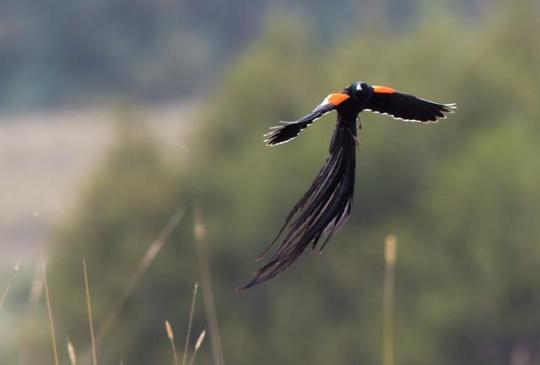



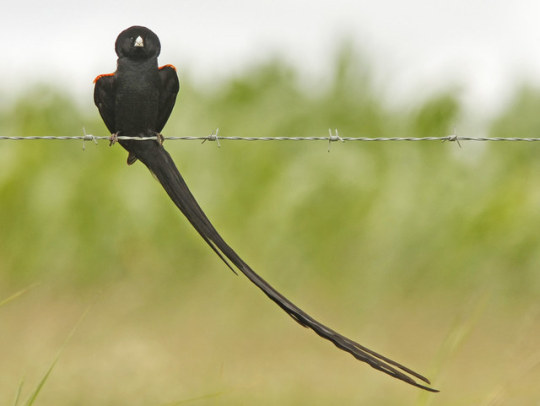
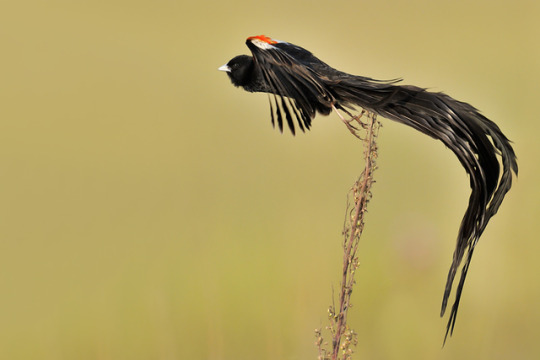

The long-tailed widowbird (Euplectes progne), also known as the "Sakabula", is a species of bird in the family Ploceidae. The species are found in Angola, Botswana, the DRCongo, Kenya, Lesotho, South Africa, Swaziland, and Zambia. The long-tailed widowbird is a medium-sized bird and one of the most common in the territories it inhabits. Adult breeding males are almost entirely black with orange and white shoulders (epaulets), long, wide tails, and a bluish white bill. Females are rather inconspicuous, their feathers streaked tawny and black with pale patches on the chest, breast and back, narrow tail feathers, and horn-colored bills. Immature males and females are very similar in appearance to the adult female. However, immature males, much like adult non-breeding males, are slightly larger than adult females.

When flying, male long-tailed widowbirds are readily visible due to their extremely long tails. Between six and eight of their twelve tail feathers are approximately half a metre (approximately 20 inches) long. The tail during flight display is expanded vertically into a deep, long keel below the male as he flies with slow wingbeats 0.5 to 2 metres (20 to 78 inches) above his territory. Because of the seemingly large cost to such male ornaments, the long-tailed widowbird has been the subject of extensive research into the function and evolution of sexually selected traits. This research has demonstrated the existence of female choice in sexual selection and indicates the trade-offs between sexual appeal and physical constraints with regard to the evolution of sexual ornaments.
Non-breeding males are slightly larger than females, though they demonstrate a remarkably similar appearance. For the most part, these males are colored in the same manner as the females, except in that they are more broadly streaked above and below and have wings and wing shoulders with the morphology of the breeding class of males. Rarely, males in the non-breeding class have elongated brownish black tail feathers, though these feathers are substantially shorter than those of the breeding class.
Long-tailed widowbirds are generally found in swampy grassland in flocks consisting of one or two males and a number of females. The males fly with their tails drooping and somewhat spread, and with slow regular movements of their wings. In wet weather, they are unable to fly due to their elongated tails. During the non-breeding season, long-tailed widowbirds congregate into flocks, which can be found roosting in reed beds.
Males defend territories in the grasslands the species inhabits. Females have a long nesting period and survey these territories and the males that inhabit them prior to mate selection. Females weave nests, shaped in large dome structures with a lining of seedheads, in the high grass within males' territories. The nests are placed 19 to 40 inches off the ground in the upper third of the high grass, where the females raise their two to three young. Females often mate with the male within whose territories they nest. Females lay one to three eggs after mating, and these are pale bluish green and streaked with brown.
The long-tailed widowbird's diet generally consists of seeds, supplemented occasionally by arthropods. The birds do most of their foraging in flocks on the ground, though they are occasionally observed hawking insects airily.
233 notes
·
View notes
Photo

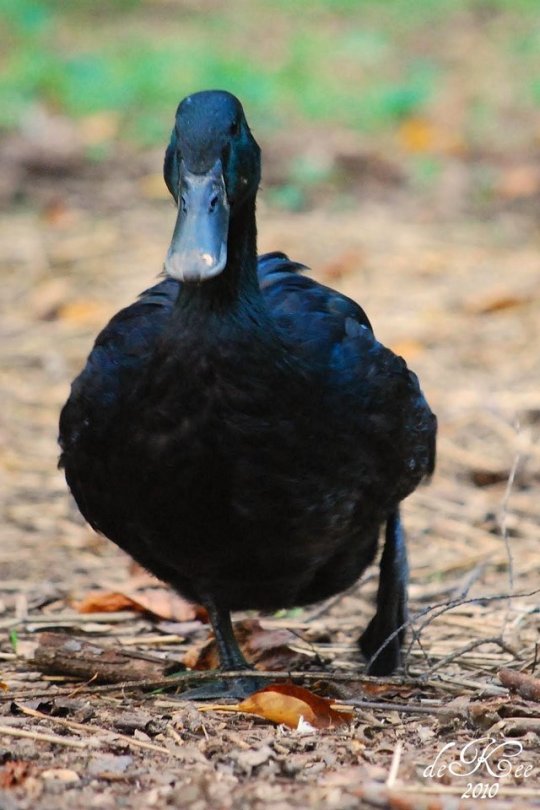
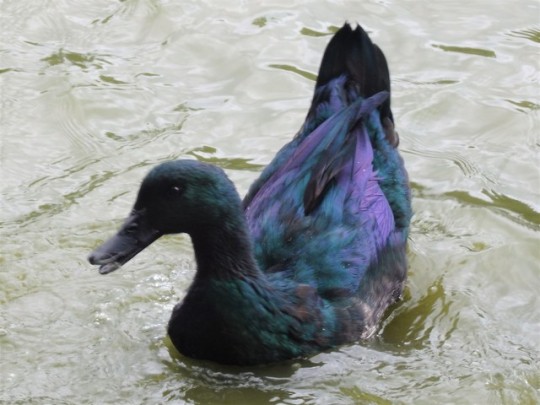

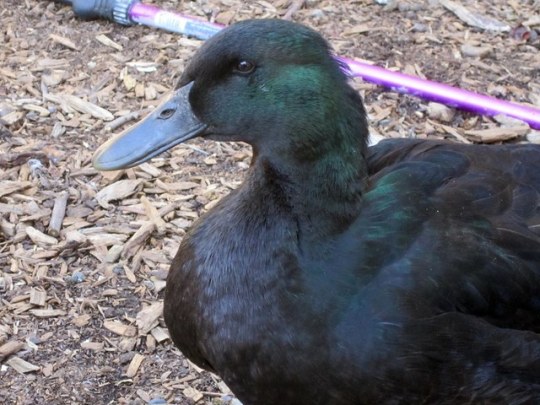


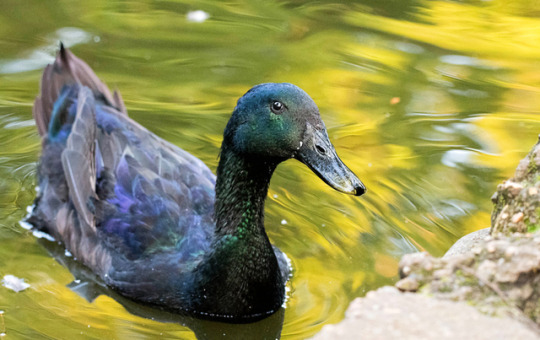
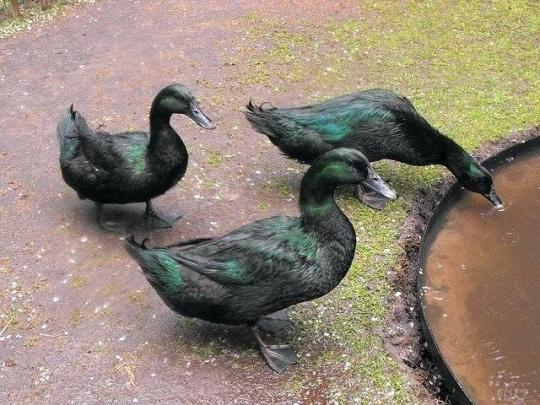

A Cayuga Duck is a medium-class domesticated duck breed that has been a popular variety in the USA since the mid-19th century. They are used for egg and meat production, as well as an ornamental bird. They are black with a green head.
The Cayuga name is taken from Cayuga Lake, one of the lakes in the Finger Lakes region of New York State, where the breed was popularized. From the available written accounts the earliest approximate date that can be ascribed to the emergence of the Cayuga Black Duck is 1830; probably from hybrids.
The American Poultry Society published its standard for the Cayuga Duck in 1867. Lewis Wright states that Cayuga Ducks were sent to him in Britain, from America, in 1871; and the breed first appears in the British Poultry Club Standards in 1874. This breed of duck is listed as threatened by the American Livestock Breeds Conservancy.
The standard weight for adult males is 8 pounds and females 7 pounds. The Cayuga are characterized by a black bill and black plumage, which is an iridescent beetle green in the correct light. In breeding, an emphasis is put on correct coloration, carriage, and a large breast. The Cayuga Duck has dark brown eyes, black shanks, and toes, except in old drakes where some orange shading may appear. Ducklings have black plumage. For exhibition presence of white color in the outer plumage is a disqualification. It is also well liked by many as a great yard pet as they tend to stay close to home. Its quack is not as loud except the females are quite vocal while often the male is mute. The temperament of the Cayuga is docile, and adult Cayuga Ducks enjoy eating snails, slugs, and most other insects.
250 notes
·
View notes